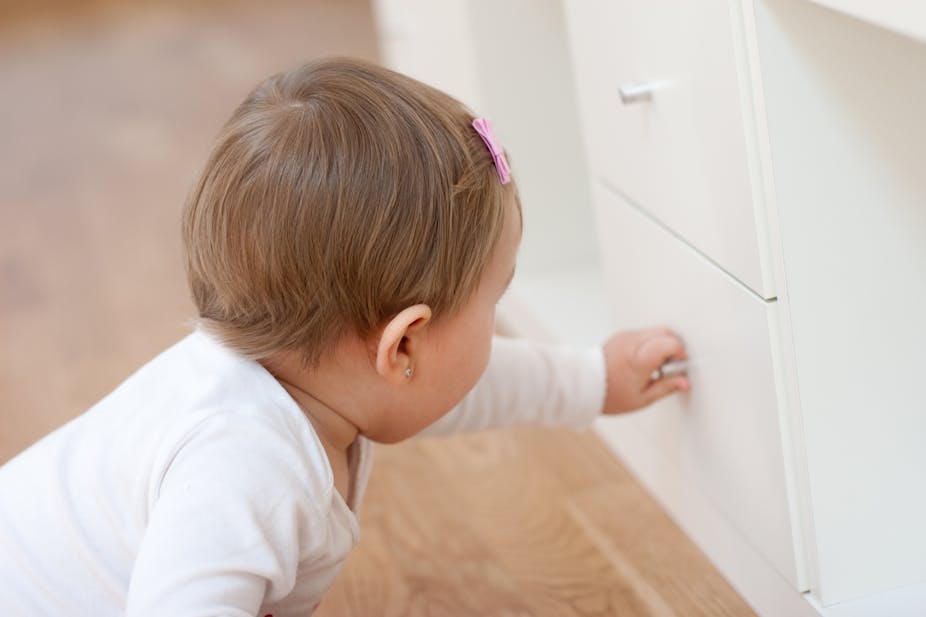The Australian Competition & Consumer Commission (ACCC) is working with manufacturers and the industry to improve battery safety after the recent death of a toddler who swallowed a lithium button battery.
Whether repackaging button batteries and re-educating consumers on their potential dangers will be an adequate is debatable because as soon as the batteries are out of the packaging, children can access them as they do now.
A long history
Summer Steer was only four years old when she swallowed a lithium button battery and died as a result. She is just one of the five Australian children taken to emergency rooms every week after swallowing such batteries. And this has been happening for a long time.
In 1984, a nine-month-old girl was presented to Westmead Hospital in Sydney with copious bleeding from the bowel. I was the paediatric surgeon on call for the day. As she was not too unwell, I booked her for an anaesthetic and examination of the lower bowel the next morning.
Her mother said that she had developed a croupy cough several days before, but we did not think that this was related to the blood in her bowel motions.
Overnight her condition deteriorated and she started to have trouble breathing. A chest X-ray showed a button battery lodged in her gullet. We took her urgently to the theatre, and the anaesthetist just managed to squeeze in an airway tube as she had almost stopped breathing.
I extracted the button battery out of her gullet where it was firmly wedged, causing inflammation and bleeding. Two days later, she coughed up a cube of tissue about the size of a game dice.
It soon became apparent that the battery had eroded a hole between her gullet and windpipe, so that food could go into her lungs and air into her stomach.
Many operations to feed her, stop infections, allow the hole to heal, and stretch up the narrowing of the gullet followed. Eventually, the child was discharged and made a recovery.
We retrospectively concluded that the battery probably came from an open, used battery discard container, under the counter of a camera shop where her mother worked and which the daughter had visited several days before the bleeding started.
With some colleagues, I wrote a paper for the Medical Journal of Australia to highlight this problem. That was in 1986.
While researching the paper, we noted a 1983 report in the Journal of the American Medical Association that reported 56 such cases, including several deaths. Through Kidsafe, we alerted government agencies of this and other foreign body problems in children.

An international issue
In 2012, I attended a workshop in Wellington, New Zealand, on the problem of button batteries. The speakers were impressive, especially the engineers. They understood that the button batteries had three essential problems made them a potentially lethal product.
The first was the size: the narrowest part of the gut is just above the junction into the stomach. The next narrowest is halfway down the gullet, just adjacent to the windpipe and just above where it divides into right and left side.
The button battery is precisely the correct size to lodge in this part of the windpipe. Any smaller and it would pass into the stomach, from where it will pass through the entire gut and be passed in the stool without any problems occurring.
The second problem is the relationship between the anode (the terminal where current flows in from outside) and cathode (the terminal where current flows out). They are close and the chemicals result in a high current passing through the adjacent salty tissues (causing tissue damage within 20 minutes under laboratory conditions).
The third problem is that the battery will still cause damage when “flat”. The battery will stop working at about 1.1 volts but still cause tissue destruction when it is below one volt.
The engineers were confident that they could design a battery that was safe. Their suggestions included altering battery size, changing the way the anode and cathode were arranged and having a cover over the electrical points when the battery was removed from its appliance.
At the Wellington workshop, it was reported that a worldwide registrar had been set up in Italy, that showed thousands of cases reported, hundreds of serious injuries and many deaths. Representatives of battery company assured us that they were aware of the problem and were working hard to rectify it.
Back to the beginning
With the recent death of Summer Steer in Queensland and the serious injury of Mackayla O’Connor in Sydney, I reviewed our experience in the last 12 years at The Children’s Hospital at Westmead. In this time, we have had 34 admissions for button battery injuries.
Based on our experience, the ACCC initiative to ensure child safe packaging would not solve the problem. Most of the time, we remain uncertain how and when the battery was ingested, but it does not seem that the child removed it from a package.
The problem seems to be the battery has become dislodged from a product, or has been discarded. The best solution is an engineering solution to make the product intrinsically safe.
My mind returns to the infant girl I treated 29 years ago. Although I have lost contact with her family, I hope she has remained well.
She is probably old enough to have had children. I am saddened to think that any children she has still face the same risks that she did, 29 years ago.

